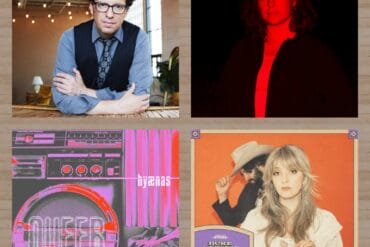The pairing of saxophonists Dave Liebman and Mike Murley could reasonably be considered a supergroup – both are masters of their instruments, and their respective CVs read like a Who’s Who in contemporary and jazz music. They’ve been playing together for more than ten years, and here they pair with fellow University of Toronto faculty Terry Clarke and Jim Vivian in this live recording, released in October.
I can only imagine what it was like actually to be present for this performance – even in digital format the playing sizzles, and the atmosphere surely must have been electric. As you’ll see in Mike Murley’s comments below, the tunes are evocative of jazz stylings of the 1960s. The quartet ramps up the energy in pieces like the opening “Split the Whole” and “Off a Bird,” and cools things down in tunes such as “Open Spaces” (my favorite on the album, if I had to pick) and the reflective “Nebula.” This is a wonderfully enjoyable album, and I hope that the Liebman/Murley Quartet can find the time in their respective schedules to return to the studio sooner rather than later.
We’re thrilled that Mike Murley took the time (over the holidays, no less!) to answer some of our questions about the project.
You’ve been performing together for quite a while now (over ten years) – what prompted you to release a live album at this stage in your collaboration?
Our playing collaboration began when Liebman was in Toronto on other business (Jazz Ed Conferences, workshops, etc) in the early 2000s. We also played at the Halifax Jazz Festival which resulted in our first recording more than a decade ago. Once he was hired as an adjunct professor at U of T the visits/gigs were more frequent and we felt if made sense to document our work together (Liebman was one of my earliest influences as a teacher and a player). The recording is also meant to promote the high quality of our jazz faculty at U of T. Liebman also made a recording with the U of T student big band in 2016, Sweet Ruby Sweet, featuring the music of Kenny Wheeler..
Many of our readers may be fairly new to jazz; since you all are also educators, how would you describe the album and the style of jazz you play to them? And if they find jazz intimidating (as I think some might), what encouragement can you offer them to dive in and discover just how wonderful it is?
The style on this recording is definitely rooted in the jazz tradition of the 1960s. The bands of John Coltrane, Miles Davis, and Ornette Coleman would be the strongest reference points. Probably the biggest challenge for listeners is that there is no chordal instrument (piano or guitar) on the recording. In many ways this gives us more freedom and space to have musical conversations within the group. I would listen in particular to how the drums interact with the soloists and how the saxophones converse with each other as well.
As I’ve been listening to the album, it’s been very easy to imagine myself sitting in a small room hearing you all live – how challenging is it to achieve that type of sound experience for a live album?
We were very fortunate to have one of the top recording engineers in Canada, Jeff Wolpert, who also happens to teach at U of T. He did a wonderful job capturing the sound, with a number of his students assisting. This was a nice collaboration for us as well. I like the immediacy and energy of live recordings.
Please forgive me in advance for being saxophone-stupid… in the opening of “Open Spaces,” is that in fact a saxophone?
Liebman has some sort of traditional flute that he plays on that piece. It suits the African flavour of the composition.
Jazz to me has always been a mysterious mix of what seems like improvisation that somehow magically ends up ‘working’ sonically and harmonically – how much is actually improvised, and how much is carefully rehearsed for a performance like this one?
Most of the music is improvised within the context of relatively simple compositional forms. Usually the “composed” section is a melody that is played at the beginning and end of the performance. Sometimes we improvise on a set form of chord changes (eg, YBSN, The Angels Sing, Small One) and other times we have a more “open” form where we improvise more freely (Split or Whole, Off a Bird, Blackwell’s Message). Ironically, probably the most “composed” and most “free” piece is Nebula. Much of that piece is composed with a short improvised section occurring around the middle/end of the performance. That piece is also challenging as it is played “out of time”, i.e. without a steady pulse or “groove”.
Are there any jazz musicians in particular who you would consider inspirations for your own careers?
As mentioned above, the bands of John Coltrane, Miles Davis, and Ornette Coleman would be high on the list. I would also include Wayne Shorter and Sonny Rollins, to name a couple of other giants.
What might we expect from the quartet in the next months and years?
I hope we do more playing but it remains to be seen how often this group will perform. Like most jazz musicians we are all involved in many musical projects. Liebman seems to be constantly travelling the world, showing no sign of slowing down in his 70s! I am very happy that we were able to document our musical relationship though this recording.
~ L


